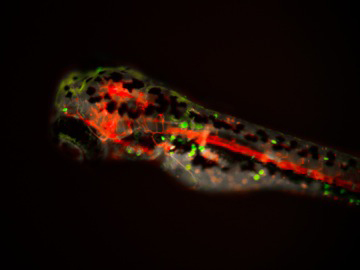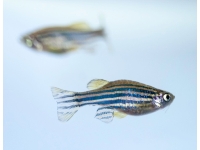A current trend of modern biomedical research is the attempt to minimalize experiments on animals like mice or chickens and where it is possible to replace them with developmentally simpler model organisms, but it is a necessary precondition that some basic cellular and physiological processes are evolutionarily conserved with these organisms, by which the similarity with the processes taking place in more complex organisms is preserved. One such biological model is the aquarium fish, the zebrafish, named for its zebra-like stripes.
It is ever more often used as a model organism for the study of
serious human diseases, such as disorders of the creation or function of red blood cells or
platelets or various types of tumour diseases including leukaemia and lymphomas. It has now been
proved that the zebrafish is a suitable model for the study of haematological illnesses also by
scientists from the Institute of Molecular Genetics (ÚMG) of the Academy of Sciences of the Czech
Republic. They show in their latest work that also such different animal species like humans and
the zebrafish have preserved a common origin of cells participating in haemostasis – the process,
which protects the organism from bleeding to death.
Whereas with mammals the most important role is played in haemostasis by nucleus-free blood
platelets, with the other vertebrates this role is performed by thrombocytes. Blood platelets and
thrombocytes are created during the process of haematopoiesis in the bone marrow, from which they
set off on an adventurous journey through the bloodstream to perform the functions assigned to
them. Whereas the blood platelets of mammals are created by the cleavage of highly specialized
multinuclear cells – megakaryocytes, non-mammalian platelets are mononuclear and meet the
characteristics of conventional cells. The main regulatory substances of haematopoiesis are the
hormones erytropoetin and thrombopoetin. Erytropoetin, infamous under the acronym EPO in the doping
affairs of sport stars, is responsible for the development of red blood cells. Thrombopoetin
regulates the development of blood platelets and thrombocytes. Unlike erytropoetinu, whose function
with zebrafish was already described by the team of Dr. Petr Bartůněk from the ÚMG ASCR,
thrombopoetin has not yet been described in fish.

Researchers therefore decided to identify the cells from which red blood cells and
thrombocytes are being developed in zebrafish in order to find the evolutionary relationship
between mammalian platelets and fish thrombocytes. In their experiments, they used transgenic
zebrafish into which they inserted the genetic information for the formation of the so-called
fluorescent proteins. Such modified zebrafish then specifically produce green and red fluorescent
proteins in different types of blood cells. That made it possible to observe and to distinguish
between fish thrombocytes and red blood cells and to identify the cells from which thrombocytes and
red blood cells were produced in fish, in which no one had been successful up until then.
Researchers from the team of Dr. Bartůněk successfully isolated and described fish thrombopoietin
and proved its stimulatory effect in the process of haematopoiesis. Somewhat surprisingly, it was
shown that mammalian megakaryocytes from which blood platelets are created are essentially the same
as non-mammalian thrombocytes. That has quite fundamentally changed the existing view of the
evolution of blood platelets.
This scientific work published in the most prestigious American haematological journal shows
that despite the differences between mammalian and non-mammalian haematopoiesis there are basic
processes of the development of blood cells that are maintained across vertebrate phylogenesis. At
the same time, it provides further evidence that the zebrafish can serve as a unique model for
studying the mechanisms of the process of haematopoiesis, some of which have been preserved for
four hundred million years, during which the branches of the phylogenetic tree of life grew into
patulous canopies.
You can find more information in the publication:
Ondřej Svoboda, David L. Stachura, Olga Machoňová, Petr Pajer, Jiří Brynda, Leonard I. Zon,
David Traver, and Petr Bartůněk. Dissection of vertebrate hematopoiesis using zebrafish
thrombopoietin. Blood. 2014 May 28. [Epub ahead of print] DOI 10.1182/blood-2014-03-564682
Abstract here.
Contact: RNDr. Petr Bartůněk, CSc., Institute of Molecular Genetics of the ASCR, v. v. i.;
tel.: 241 063 117, email: bartunek@img.cas.cz, http://www.img.cas.cz/research-groups/petr-bartunek/
Prepared by: The Institute of Molecular Genetics of the ASCR
11 Jul 2014






